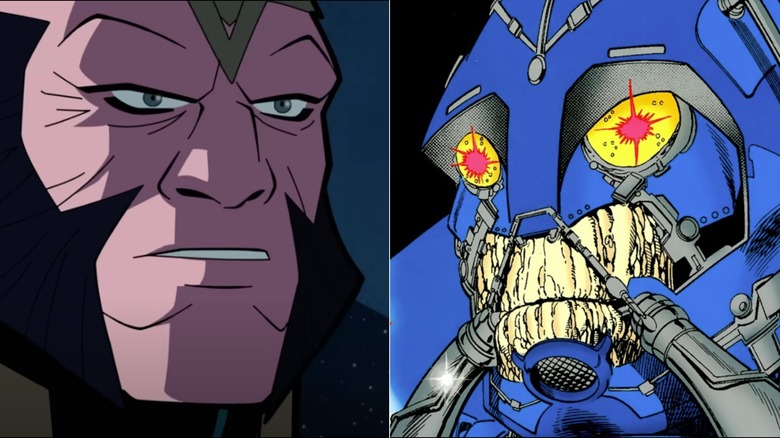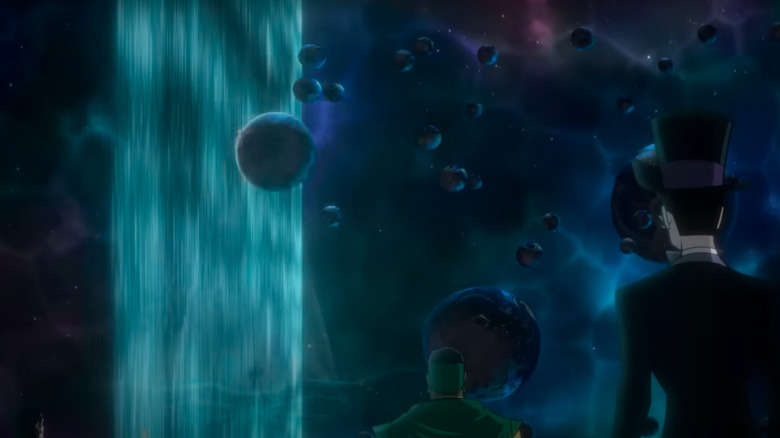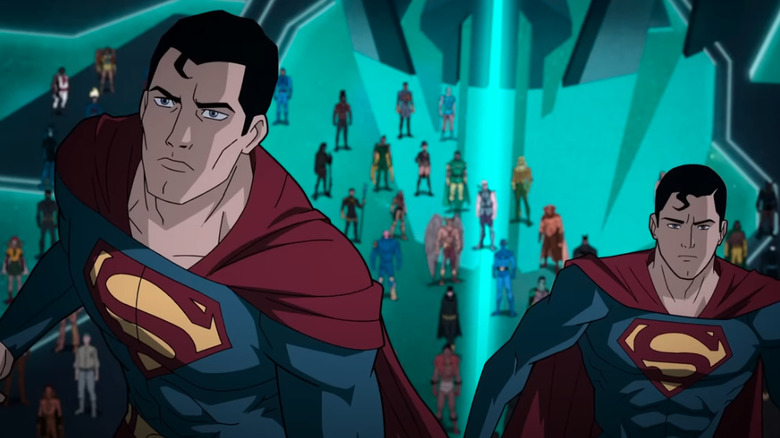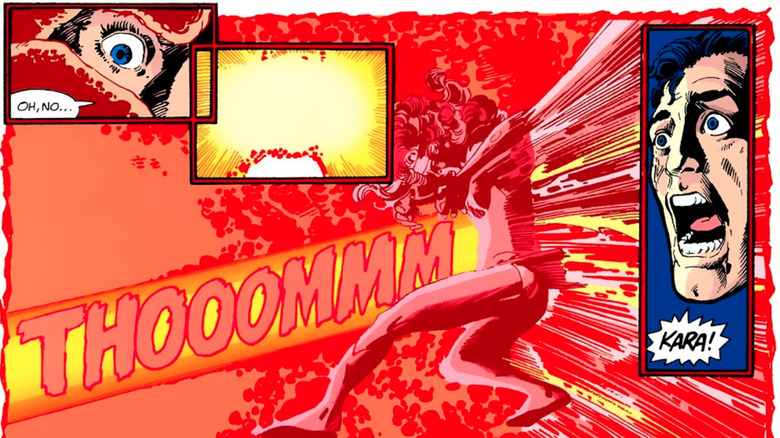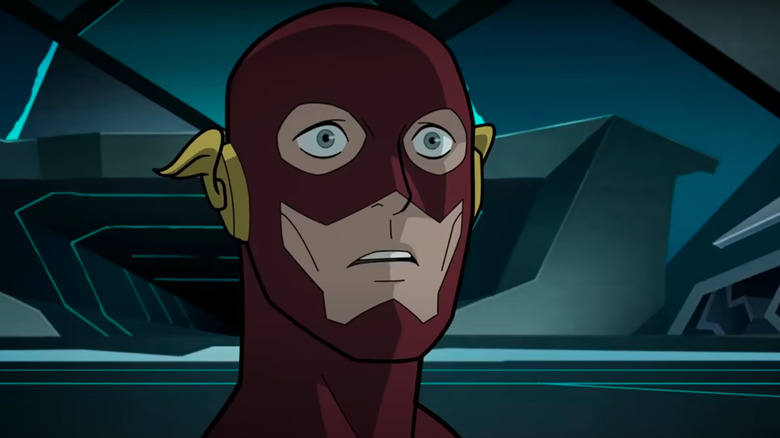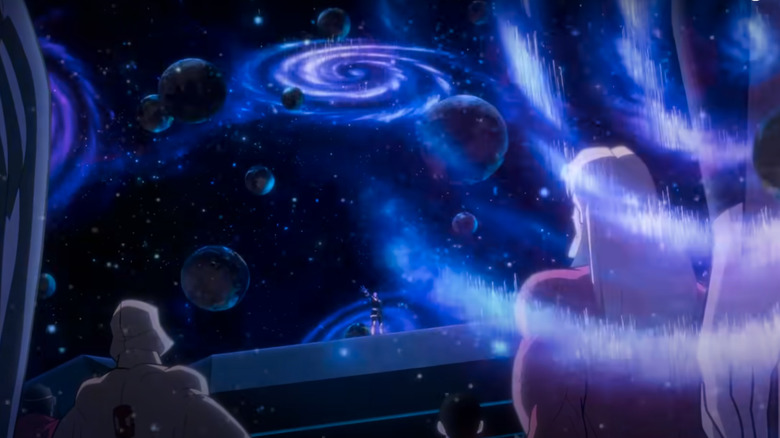Justice League: Crisis Trailer - What On Infinite Earths Is Going On?
The upcoming animated "Justice League: Crisis on Infinite Earths" is kind of a big deal. So big, in fact, that the trailer reveals the story will unfold over no less than three movies. For fans who are familiar with the event, the trilogy decision may not come as a surprise. The story is as huge as they come, as the previous adaptation — The CW's Arrowverse "Crisis on Infinite Earths" crossover — readily shows.
But what, exactly, is the story about? With its short clips of various heroes either looking worried or striking dynamic poses, the trailer offers precious few clues. What's more, it also features several characters who are far more difficult to figure out than the titular team's usual allies and foes, including two different Supermen, for some reason. What's all that about?
As it happens, all of this and more is only to be expected when it comes to an adaptation of "Crisis on Infinite Earths," the 1985 comic book storyline that effectively rebooted the entire DC Comics universe at the time, and affected some of its best-known characters in profound ways. Since the movie trilogy is co-written by Marv Wolfman — the writer of the original comic book event — there's every chance to believe that the story won't stray too far from the source material. With this in mind, let's take a quick crash course on this huge event.
A struggle between the Monitor and the Anti-Monitor
Just like you might suspect, the character who narrates the "Crisis" trailer is important. The Monitor (Jonathan Adams) represents all that's positive in the universe — just like the story's big villain is a force of pure destruction. Born billions of years ago as a guardian of the universe's positive matter, the Monitor acts as a counterbalance to the Anti-Monitor (Adams), who embodies the wicked energies of an antimatter universe that spun into existence when the Multiverse was created and seeks to destroy all matter.
The pair's first confrontation is evenly matched and puts them both out of commission for billions of years. When the Anti-Monitor wakes up slightly earlier than the Monitor, he immediately starts destroying universes and absorbing their power, thus gaining an edge over his enemy. "Crisis on Infinite Earths" picks up at a point where the Anti-Monitor is already well on his way to victory, and the Monitor has grown far too weak to oppose his rival directly. As such, the complex events that unfold are all part of the Monitor's last, desperate plan to stop the Anti-Monitor's rampage and save what can be saved.
The Monitor's plan is convoluted even by comic book standards, and what's more, the Anti-Monitor isn't revealed until the end of the "Worlds in Limbo" arc, roughly halfway into the story. As such, the reader and the characters alike spend a significant part of the story without knowing what the cataclysmic situation is all about. Knowing this, it may be a good thing that the animated version comes in three parts — this way, there's plenty of room for the lengthy setup the story likely requires.
The story condenses the DC Multiverse into a single universe
To get around the fact that he can't directly face his adversary, the Monitor unleashes a last, desperate effort: He rigs a handful of select multiversal locations with massive cosmic tuning fork towers and recruits a number of carefully vetted heroes and villains to help him stop the Anti-Monitor's rampage.
Surprisingly few members of this initial special force are famous Justice League names — at least, the versions of them the reader is familiar with. However, as the plot progresses, pretty much every familiar face in the DC Comics universe joins the good fight in one way or another. On the Multiverse-ending corner, the Anti-Monitor is a terrifying force in his own right — a menacing creature who wields vast energies and can create a wall of antimatter that can take out whole universes. He also commands a shadow army that the heroes find extremely challenging to fight off.
As the plot progresses, the multiple realities start to bleed into each other, eventually creating a situation where all the surviving universes exist in one unstable space. By its conclusion, the story brings all of DC's alternate realities into one compact, single-universe package. Of course, later events — 2005's "Infinite Crisis" in particular — have had something to say about the permanence of this situation, but "Crisis on Infinite Earths" still counts as a pretty major overhaul of the DC status quo.
Fans of obscure characters are in for a treat
Apart from the Monitor and the Anti-Monitor, there are so many players on the table that it's impossible to name all major figures in the story — but suffice it to say, "Crisis on Infinite Earths" isn't afraid of deep cuts. The crossover happily mines every single inch of its multiversal nature and uses the opportunity to feature little-known characters like Arion, Lord of Atlantis, and Solovar the Gorilla King at least as prominently as Superman or Batman, especially early on.
Some major players the viewer can expect to encounter include Pariah, who accidentally wakes up the Anti-Monitor and becomes locked in a horrifying existence where he has to witness the last moments of all the universes the villain destroys. Alexander Luthor Jr., a man comprised of both matter and antimatter who's the sole survivor from a destroyed universe where his father was a superhero, also plays a prominent role. So does the new Doctor Light, as well as the Monitor's stepdaughter, Harbinger ... among many, many others.
In other words, this is the kind of story that can — and absolutely will — make someone like the small-time emotion-manipulating supervillain Psycho-Pirate a critical character. Of course, the story also features plenty of A-list superheroes and villains side by side with the obscure ones. It remains to be seen whether the movie trilogy is willing to dig quite as deep into DC's superhero arsenal as the comics do, but it's probably safe to say that some pretty wild names might turn up.
Expect several shocking deaths
As befits a story arc that has no problem destroying entire universes, "Crisis on Infinite Earths" has its share of character deaths. In fact, the comic book story opens with the destruction of the Earth-Three universe. Much of the horror unfolds through the eyes of the villainous alternate-universe Justice League, the Crime Syndicate of America – and its leader, Ultraman, who gets a huge and nasty wake-up call after a lifetime of villainy.
Perhaps the most shocking death in the story is that of Supergirl. She takes the Anti-Monitor to the absolute limit in the heroes' first direct confrontation with the villain during the "Beyond the Silent Night" arc but ultimately dies at the hands of the universe destroyer. Fortunately, her sacrifice buys the remaining universes crucial time to recuperate and marks one of the major turning points in the story.
The Barry Allen version of The Flash is another major casualty. His death is telegraphed early on, as he's seen appearing to other heroes in various stages of distress well before "A Flash of the Lightning" reveals what happens to him. Barry, who has been imprisoned by the Anti-Monitor and the Psycho-Pirate for much of the story, breaks free and uses his powers to destroy the former's doomsday weapon, but tragically disintegrates in the process. As it happens, both Supergirl and the Flash get plenty of attention in the "Justice League: Crisis on Infinite Earths" trailer, so things aren't exactly looking up for the pair in the animated adaptation either.
The regular supervillains are making trouble, as well
If "Crisis on Infinite Earths" seems like a bit too high-concept with its multiversal stakes and Monitor-on-Anti-Monitor action, it's worth noting that there's still plenty of classic superhero comics action going on. For much of the story, DC's usual major supervillains like the Joker and Lex Luthor play a relatively small role, but the "War Zone" arc brings them back in a major way. United under Brainiac and Luthor, the worst of the remaining universes' baddies recognize their chance to bring the weakened worlds under their heel and start making moves. Battles aplenty follow.
The "Justice League: Crisis on Infinite Earths" trailer doesn't offer many clues about this particular plot line, but in the comics, it's a fairly integral lead-up to the grand finale where everyone joins forces against the rejuvenated Anti-Monitor. Because of this, there's a decent chance that the trilogy will feature a laundry list of familiar DC villains.
Crisis on Infinite Earths is just one of the many DC crises
"Crisis on Infinite Earths" is a pretty big deal, but in the grand scheme of things, it's also just one of the many crisis events the DC Comics universe has gone through over the years. In fact, "Crisis" is something of a blanket term for DC crossover events that are large and threatening enough.
In many ways, "Crisis on Infinite Earths" is the culmination point of the multiversal plot points the preceding crises set up. For example, 1963's "Crisis on Earth-One" features the Justice League of America and Earth-Two's Justice Society of America. In 1964, "Crisis on Earth-Three" is about the titular universe's evil Crime Society of America — the same one that meets its fate during the events of "Crisis on Infinite Earths." Such events help create the foundation that this mega-event uses to paint a picture of utter destruction, as its plot joins, twists, and destroys the worlds that the previous comics set up.
It will be interesting to see whether the "Justice League: Crisis on Infinite Earths" trilogy takes some time to feature some of these mini-crises that serve as instrumental setup to the carnage that unfolds, or if it simply assumes that the viewer is already familiar with the backstory and jumps headfirst in the deep end. Regardless of what happens, there's definitely no shortage of source material to draw from.
